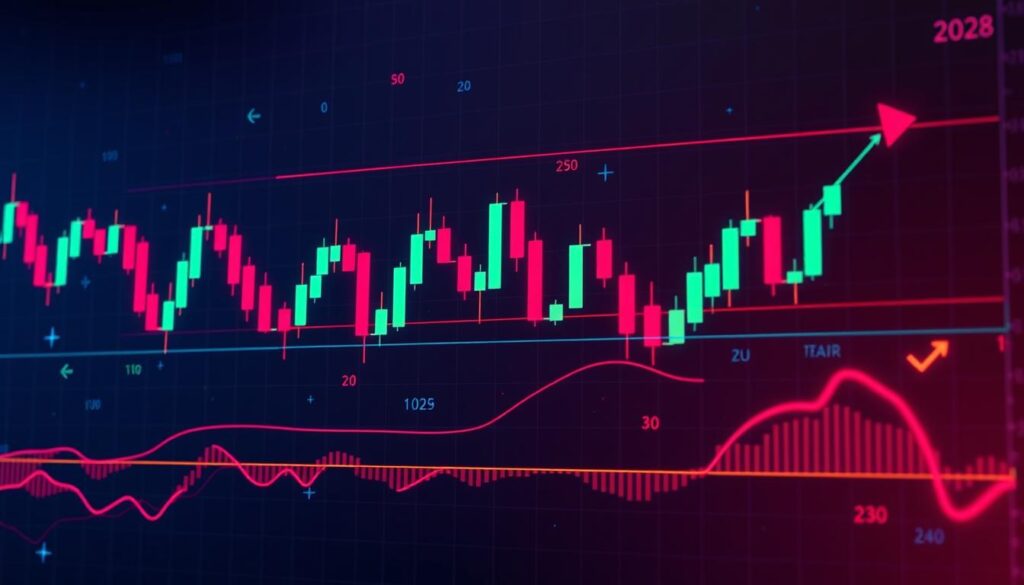Stock chart patterns are unique shapes on price charts. They help traders see when the market is stable and predict future trends. These patterns are key for both long-term investing and quick day trading.
Even though chart patterns offer useful insights, they’re not always right. Traders should look at these patterns alongside other analysis methods. They should also think about the company’s health and their own risk comfort when trading.
Key Takeaways
- Stock chart patterns offer insights into potential market trends and trading opportunities.
- Patterns with more data points, such as trendlines with three or more points, are generally more reliable.
- Reversal patterns signal a change in the prevailing trend, while continuation patterns suggest a temporary pause before the trend resumes.
- Understanding the characteristics and behavior of different chart patterns is crucial for making informed trading decisions.
- Combining chart pattern analysis with other technical indicators and fundamental analysis can enhance trading strategies.
What Are Stock Chart Patterns?
Stock chart patterns are specific price movement shapes that traders look for. They help spot trends and guess where the market might go next. By studying trendlines, support and resistance, and price action, traders can predict big changes or ongoing trends.
Definition and Importance
Chart patterns show how prices move in charts. They give traders and investors clues about market feelings and intentions. Knowing these patterns can lead to better trading, helping find when to buy or sell and where to set limits.
Key Characteristics
- Chart patterns are made by trend lines and curves from price changes over time.
- They can be either reversal or continuation patterns. Reversals show a trend change, while continuations mean the trend keeps going.
- Understanding chart patterns well needs knowing market psychology. They show how traders act together.
“Chart patterns are the building blocks of technical analysis, providing traders with a visual representation of market sentiment and potential future price movements.”
Learning to spot chart patterns can give traders a big advantage. It can make their trading better and more successful.
Types of Stock Chart Patterns
Stock chart patterns are key in technical analysis for spotting trading chances. They fall into two main types: reversal and continuation patterns.
Reversal Patterns
Patterns like the Head and Shoulders, Double Tops and Bottoms, and Triple Tops and Bottoms show a trend change might be coming. They hint at a shift in market direction, offering traders a chance to profit from trend reversal moves.
Continuation Patterns
Continuation patterns like Flags and Pennants, Ascending and Descending Triangles hint at a short pause before the trend goes on. These patterns often lead to consolidation patterns and breakout patterns, setting the stage for a price move in the trend’s direction.
“Understanding the characteristics and implications of various stock chart patterns is essential for traders seeking to improve their decision-making and increase their chances of success in the markets.”
Knowing these chart patterns helps traders predict trend reversals and continuation moves. This knowledge boosts their trading strategy and performance.
Understanding Reversal Patterns
Reversal patterns are key in technical analysis. They show when a trend might change. By spotting these patterns, traders can guess the market’s next move.
Head and Shoulders
The Head and Shoulders pattern is a bearish sign. It has three peaks, with the middle one being the highest. The outer peaks are lower.
This pattern shows a failed try to pass a resistance level. It often leads to a trend change downward. The neckline, a line between the shoulders’ lows, is key. Breaking below it confirms a bearish signal.
Double Tops and Bottoms
Double Top and Double Bottom patterns are important too. A Double Top looks like an “M” and shows a failed push past a resistance level. It hints at a bearish reversal.
A Double Bottom looks like a “W” and shows a failed push past a support level. It hints at a bullish reversal. These patterns take weeks to months to form and offer valuable insights.
Triple Tops and Bottoms
Triple Tops and Bottoms patterns are similar but with three attempts. A Triple Top suggests a bearish reversal. A Triple Bottom suggests a bullish reversal. These patterns are less common but still significant.
Knowing these patterns helps traders and investors make better choices. They offer key insights into the market’s direction. By using this knowledge with other tools, traders can better navigate the markets.
“Patterns in stock trading are repetitive, providing traders with known outcomes; however, they may not always behave as expected due to other market factors.”
Exploring Continuation Patterns
In the world of technical analysis, continuation patterns are key to spotting market trends. They differ from reversal patterns, which show a change in direction. Instead, continuation patterns hint at a brief pause before the trend continues. Flags, pennants, ascending, and descending triangles are common examples.
Flags and Pennants
Flags and pennants form after a quick price move, followed by a calm period. They look like small flags or pennants. These patterns hint at a possible continuation of the trend, depending on the previous direction. Traders use them to plan their trades and time their entries well.
Ascending and Descending Triangles
Triangles, including symmetrical triangles, are well-known continuation patterns. They show a consolidation period before a breakout. Ascending triangles point to an upward trend, while descending triangles suggest a downward trend.
Symmetrical triangles, however, can break in either direction. This makes them tricky to read. Traders use these patterns to find good entry points, set stop-loss levels, and aim for profit targets.
“Understanding continuation patterns and creating a trading plan based on them are crucial to the success of a technical analyst.”
By spotting and understanding these patterns, traders can better grasp market dynamics. This helps them make smarter trading choices.
How to Read Stock Charts
Learning to read stock charts is key for any trader. You need to know the basics and spot common patterns. This helps you understand price movements, trends, and key market levels.
Basic Charting Techniques
First, find the stock’s overall trend. An uptrend has higher highs and lows, while a downtrend has lower ones. Drawing trendlines helps see the market’s direction. Look closely at support and resistance levels, as they can stop or start price changes.
Candlestick Patterns
Candlestick charts show short-term price actions. Learn about patterns like the doji, hammer, and engulfing patterns. These signs can point to support, resistance, or trend changes.
“The key to successful trading is to read the market, not the news.” – Jesse Livermore
Mastering charting basics and candlestick patterns is essential. It lets you understand price actions, trends, and key levels. This knowledge is vital for making smart trading choices and boosting your success.
The Role of Volume in Chart Patterns
In stock trading, volume is key in confirming chart patterns and breakouts. It shows the market’s mood and trend strength. The number of shares traded gives insights into these areas.
Volume Analysis Basics
Volume usually goes up with the trend. For instance, in an uptrend, more shares are traded on up days. Volume drops during pattern formation, then spikes during breakouts.
Volume Confirmation
Confirming volume is vital for pattern and breakout validation. A breakout with high volume signals a real market move. Low volume might mean a false breakout. Volume analysis helps understand market sentiment and breakout confirmation.
Adding volume analysis to your strategy can offer valuable insights. It helps in making better trading volume decisions. Knowing volume’s role in chart patterns is key to a successful trading approach.
“Volume is the fuel that drives the engine of a trend. Without volume, a trend cannot be sustained.” – William O’Neil, founder of Investor’s Business Daily
Incorporating Technical Indicators
In stock trading, technical analysis is key. It’s more than just looking at chart patterns. By using technical indicators, you can understand market trends and changes better. Moving averages and the Relative Strength Index (RSI) are two popular tools for this.
Moving Averages
Moving averages smooth out price movements. They help show the market’s direction. There are different types, like simple and exponential moving averages. Traders use them to check trend strength and find support and resistance levels.
Relative Strength Index (RSI)
The Relative Strength Index (RSI) shows how fast and how much prices change. It ranges from 0 to 100. Levels over 70 mean prices are too high, and levels under 30 mean they’re too low. Traders use RSI to spot when prices might change direction.
Using moving averages and RSI in your trading can make you a better trader. These tools give you more information to help you make smart trading decisions. They work together with chart patterns to give a full picture of the market.
“The combination of chart patterns and technical indicators can be a powerful tool for traders, providing a more comprehensive understanding of market dynamics and increasing the likelihood of successful trades.”
Technical analysis is a journey. It’s important to keep learning and adjusting your strategies as the market changes. Try out different indicators, test your ideas, and find what works best for you.
Best Practices for Trading with Chart Patterns
Trading with stock chart patterns needs careful planning. You must set clear entry and exit points. Also, it’s important to manage risks well.
Wait for the pattern to confirm before you trade. Make sure the pattern is fully formed before acting.
Setting Entry and Exit Points
Identifying clear entry and exit points is key. Look for pattern confirmation before trading. This could be a breakout or reaching a specific price target.
Set profit targets based on pattern projections or key levels. These levels are important for support and resistance.
Risk Management Strategies
- Use stop-loss orders to limit losses and manage risk.
- Practice proper position sizing to match your risk-to-reward ratio with your plan.
- Keep an eye on the broader market and use other indicators to check chart pattern signals.
No chart pattern is 100% reliable. Trading should be done with caution. Never risk more than you can afford to lose.
By combining chart pattern analysis with good risk management, you can improve your trading success.
“The key to successful trading is not to get right the first time, but to get it right over time.”
Common Mistakes to Avoid
Stock chart patterns can be a great tool for traders, but they come with risks. Traders need to watch out for common mistakes that can hurt their success. These mistakes can make it hard to spot patterns and make money from market changes.
Overtrading Patterns
One big mistake is getting too caught up in chart patterns without seeing the bigger picture. Trying to force patterns on charts or chasing after them can lead to bad signals and higher risks. It’s important for traders to stay disciplined and follow a solid trading plan.
Ignoring Market Trends
Traders also need to keep an eye on the overall market trends. Not looking at the bigger picture can lead to making trades that don’t match the market’s mood. To avoid this, traders should look at patterns alongside other market factors like big economic news and how people feel about the market.
Another mistake is confirmation bias. This is when traders only look at information that supports their views, ignoring anything that goes against them. This can lead to quick, bad decisions and more chances of false breakouts.
Good risk management is key when trading patterns. Not using stop-loss orders or risking too much can lead to big losses if the market moves against you.
To beat these challenges, traders should mix their pattern analysis with a deep understanding of market trends, volume, and other technical tools. By being balanced and disciplined, traders can better handle chart patterns and boost their chances of success.
Case Studies: Successful Trades using Patterns
Learning how to use stock chart patterns is key for traders aiming for steady success. By looking at real trading examples, we learn a lot. We see how traders make decisions, manage risks, and spot patterns in the market.
Real-Life Examples
One great example is the Berger Paints share trade in August 2020. A trader spotted a bullish head-and-shoulders pattern. They bought in and set a stop-loss at Rs. 680. By January 2021, they made a 37% profit, thanks to a good risk-reward ratio.
Dr. Lal Path Labs also saw a successful trade. A trader found an ascending triangle pattern. They set a stop-loss at Rs. 2,107. This allowed them to make big gains while keeping their risk low.
Lessons Learned
- Trading psychology and disciplined action are key. The successful traders were patient, controlled their emotions, and knew how to analyze markets and set risk-reward ratios.
- Spotting chart patterns right is vital. Recognizing patterns like head-and-shoulders and ascending triangles helped the traders time their moves well.
- Good risk management is crucial. Using stop-loss levels and sizing positions wisely helped limit losses and boost profits.
These examples show the value of always learning, being flexible, and trading with discipline. By studying these trades, traders can improve their skills, work on their trading psychology, and boost their success in the markets.
“The key to successful trading is not just identifying patterns, but also understanding the underlying market dynamics and having the discipline to execute trades with proper risk management.”
Tools and Resources for Analyzing Patterns
In the world of technical analysis, traders have many tools and resources. These help them understand and spot stock chart patterns. From advanced charting software to educational materials, these tools are key to mastering pattern recognition.
Charting Software Options
Charting software is crucial for analyzing patterns. Popular choices include TradingView, MetaTrader, and broker platforms. These tools have advanced algorithms and customizable indicators. They help traders explore chart patterns in detail.
Educational Resources
Traders can also learn from educational resources. Books by John Murphy, Thomas Bulkowski, and Steve Nison are great. Online courses and webinars from financial institutions and educators offer deep insights. They teach how to apply chart patterns in trading.
By using technical analysis tools, trading platforms, and online courses, traders can grasp chart patterns. They can improve their skills in spotting and using these trading signals.
“The secret to successful trading lies in mastering the art of pattern recognition. With the right tools and resources, traders can unlock the full potential of chart patterns to navigate the markets with confidence.”
Conclusion: Mastering Stock Chart Patterns
Learning to trade with stock chart patterns is a journey that never ends. It takes hard work, practice, and a constant desire to learn more. This guide has shown how important it is to know different patterns and how they help spot trends and chances.
Recap of Key Takeaways
Traders need to check chart patterns with tools like volume and moving averages. This makes winning trades more likely. Also, having a good plan for managing risks is key. It helps avoid big losses and increase gains.
Next Steps for Traders
Start building a trading plan that uses chart patterns well. Begin by practicing with fake money to get better at recognizing patterns. Keep a journal of your trades to see what works and what doesn’t. Stay up-to-date with market changes and new ways to analyze data to keep your strategy sharp.
FAQ
What are stock chart patterns?
Stock chart patterns are unique shapes on price charts. They help traders see when the market is stable and predict future trends. These patterns are key for both long-term investing and quick day trading.
How are stock chart patterns classified?
Patterns are divided into two types. Reversal patterns show when a trend might change. Continuation patterns indicate a trend will continue after a short pause.
What are some examples of reversal patterns?
Reversal patterns include the Head and Shoulders and Double Tops and Bottoms. These patterns take weeks to months to form. They offer insights for both short-term traders and long-term investors.
How do continuation patterns work?
Patterns like Flags and Pennants suggest a trend pause before it continues. They help traders enter or add to positions in the current trend direction.
What role does volume play in confirming chart patterns?
Volume is key in confirming patterns and breakouts. It should rise with the trend. A big volume spike often signals a real breakout, helping traders make better choices.
How can technical indicators complement chart pattern analysis?
Indicators like Moving Averages and RSI add to chart pattern analysis. They provide more data for traders. Using them with patterns can improve trading strategies.
What are some common mistakes to avoid when trading with chart patterns?
Traders should avoid overtrading, ignoring the big picture, and not checking volume on breakouts. They should also watch out for confirmation bias and not make rash decisions.
What resources are available to help traders analyze chart patterns?
Traders can use software like TradingView and MetaTrader for pattern recognition. Books, online courses, and webinars also offer deep insights into chart patterns and technical analysis.







